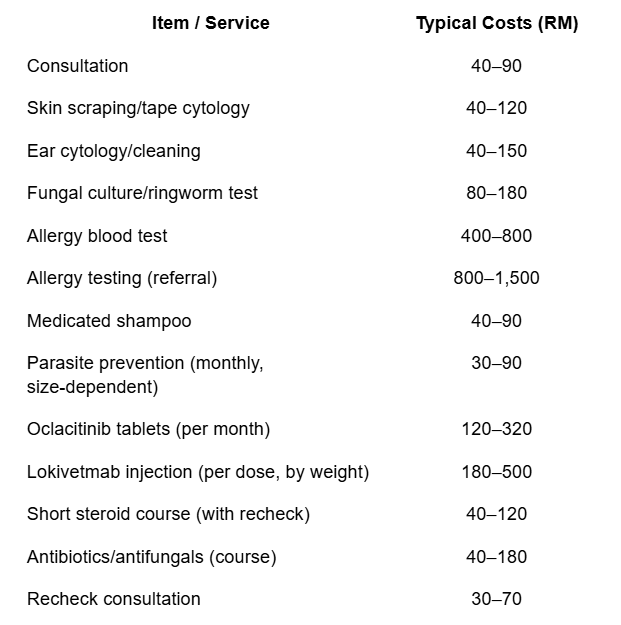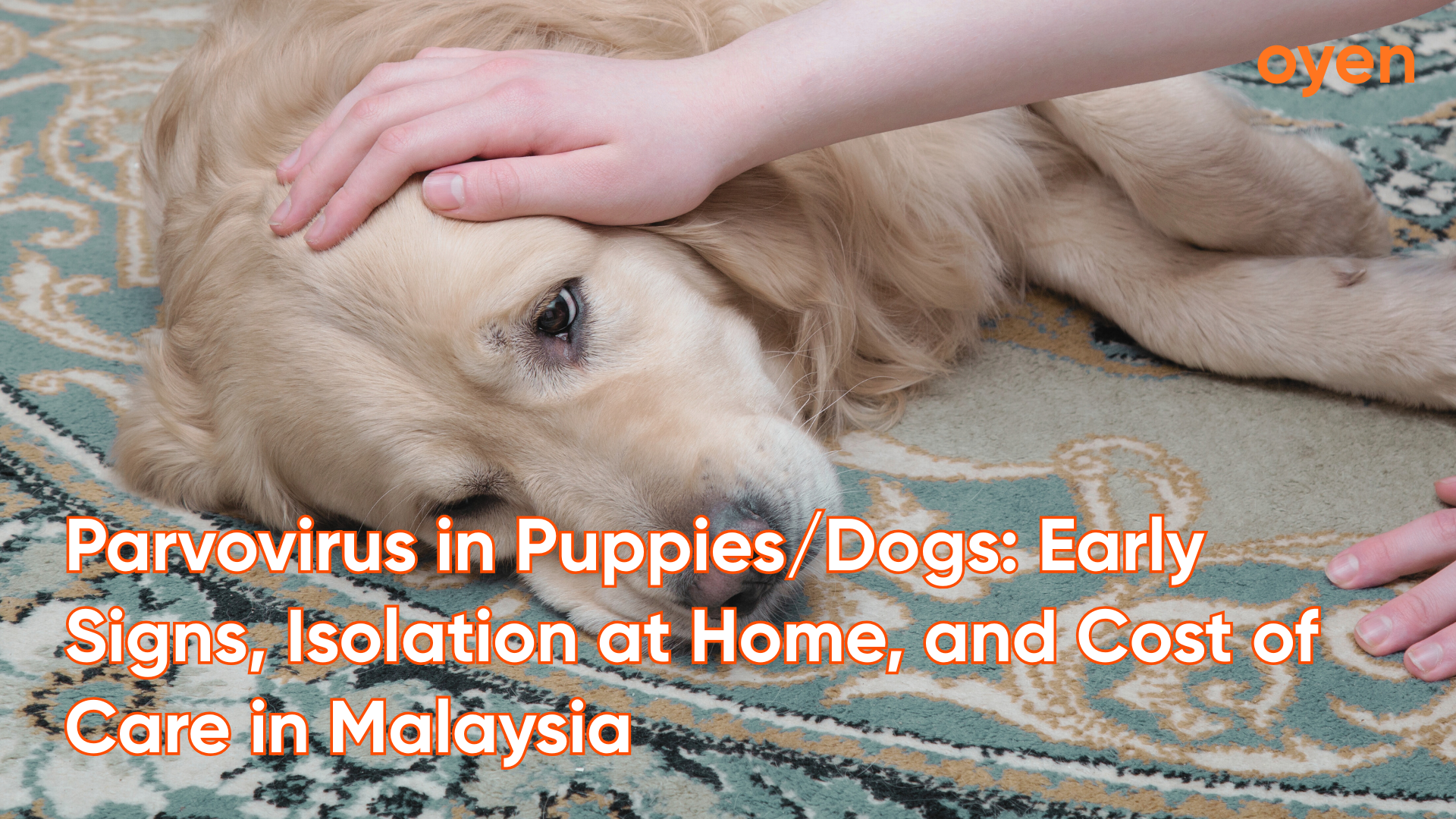Not medical advice—please consult your vet.
Skin allergies amongst dogs are common in Malaysia. Heat, humidity, and year-round pests make itchy skin flare more often than in temperate countries. Most dogs do well with a simple plan: control the trigger, soothe the skin, and treat any infection early. Here’s how that looks in the Malaysian context.
What “skin allergy” usually means here
“Skin allergy” is a broad label. In practice, vets in Malaysia mostly see three buckets: flea allergy dermatitis, environmental allergies (dust mites, moulds, grasses, tree pollens), and food reactions. Many dogs have a mix. You’ll notice persistent scratching, paw chewing, ear redness, and a musty or “yeasty” smell after rain. Because humidity slows skin recovery and favours yeast overgrowth, mild rashes can spiral into hot spots quickly.
The takeaway: treat early and keep the skin dry and calm.
.png)
Triggers made worse by Malaysia’s climate
Humidity and heat keep allergens on the coat longer and weaken the skin barrier. Dust mites thrive in fabric sofas, rugs, and bedding, especially in high-rise homes with limited sun exposure.
Outdoor dogs in landed homes meet grass pollens year-round; indoor dogs in condos face cleaning chemicals, fragrance diffusers, and recycled air. Sabah/Sarawak coastal areas see heavy monsoon periods that prolong dampness; Klang Valley’s urban dust adds to irritation. For example, a dog that’s fine in January can flare in March after two weeks of rain and skipped blow-dries.
Practical takeaway: manage moisture first—rinse, dry, and reduce indoor dust.
Signs to watch, and when to get help
Itch that interrupts sleep, constant paw-licking, head shaking, or red moist patches are warning signs. Ear problems often travel with skin allergies, and repeated ear infections point to an underlying trigger rather than “just dirty ears.”
If you see open sores, a sour smell, or your dog seems flat or off-food, that’s vet territory. In short, home care can calm mild itch for a day or two; ongoing or severe signs need a diagnosis.
What your vet might do (diagnostics you’ll hear about)
Vets start with a physical exam and history, then add simple tests.
Skin scrapings check for mites; tape or swab cytology looks for yeast and bacteria; ear cytology guides ear drops; and a wood’s lamp or fungal culture may be used if ringworm is suspected.
If food is on the list, a strict elimination diet runs for 8–12 weeks before any “treat challenge.”
For environmental allergy control, some vets order serum allergy tests; others refer for intradermal testing.
For example, a dog with year-round itch and clean cytology may be a better candidate for allergy testing and immunotherapy.
Takeaway: ask which test will change the treatment plan today.
Treatment options in Malaysia
.png)
Vets commonly use oclacitinib (Apoquel, tablet) or lokivetmab (Cytopoint, injection) for moderate-to-severe itch.
In our experience with Oyen customers, these medicines can be highly effective but costly, and some dogs need them long term—Apoquel often daily; Cytopoint roughly every 4–8 weeks, depending on response. Expect typical monthly spends in the RM120–320 range for Apoquel and RM180–500 per injection for Cytopoint (weight-dependent). Short steroid bursts still have a place for hot spots or severe flares, but vets aim to taper quickly to reduce side effects.
If cytology shows yeast or bacteria, add a medicated shampoo routine and targeted anti-microbials to reset the skin. Parasite control is non-negotiable: even one flea bite can trigger days of itch in allergic dogs, so a monthly isoxazoline chew often breaks the cycle within weeks. From there, keep the barrier healthy—regular bathing (proper contact time), full blow-dry on a cool setting, and paw rinse-and-dry after wet walks.
Because ongoing meds add up, plan for step-downs once the skin is quiet: stretch Cytopoint intervals if stable, review Apoquel dose with your vet, and remove “itch amplifiers” (fleas, secondary infections, fragranced products, damp bedding). If itch keeps bouncing back, move to structured diet trials or discuss allergy testing and immunotherapy to cut flare frequency over time. In short: relieve fast, control triggers, and review regularly so you’re not paying for more medicine than you need.
Safe home care between vet visits
Bathing helps when done right. Use a gentle hypoallergenic or antiseborrheic shampoo, lather for 5–10 minutes, then rinse thoroughly and blow-dry on a cool setting.
After walks on wet grass, a quick paw rinse and dry stops pollen and yeast build-up.
Wash bedding weekly; if your washer lacks hot water, sun-dry outdoors midday when possible.
Keep rooms airy; air-conditioning reduces humidity but avoid strong fragrance diffusers.
Food changes should be deliberate - pick one complete diet (novel protein or hydrolysed, if advised) and stick with it strictly during a trial. Practical takeaway: consistency beats constant product switching.
One short checklist for daily care:
- Monthly parasite prevention; mark the date.
- Rinse-and-dry paws after wet walks.
- Bathe every 1–2 weeks during flares; blow-dry fully.
- Wash bedding weekly; vacuum sofas and rugs.
Typical costs in Malaysia (MYR)
Fees vary by clinic, state, and dog size. 24-hour or specialist clinics may charge more. Use these as planning ranges.

*Actual fees vary by clinic/location.
Parasites: the Malaysian allergy accelerator
Even indoor dogs get flea bites through shared lifts, cleaning trolleys, or visits to parks.
Ticks are common after hikes in Selangor, Penang, or Johor coastal trails. Because a single bite can trigger days of itch in flea-allergic dogs, monthly prevention is cheaper than weeks of medication. For example, starting a chewable isoxazoline now and repeating monthly often reduces scratching within two to three weeks.
Takeaway: don’t skip prevention even if you haven’t “seen” fleas.
Food and environmental angles (how to tell them apart)
Food reactions don’t always cause tummy upset; many show as ear or paw itch.
The only reliable test is a strict elimination diet: one vet-recommended protein and carb (or a hydrolysed diet) for 8–12 weeks, no treats or flavoured meds. If signs improve and return after a test treat, food is part of the issue.
Environmental allergies wax and wane with seasons, cleaning routines, and rainfall. A dog that worsens after grooming sprays but improves on fragrance-free shampoo likely reacts to products, not food. In short, change one thing at a time and track the result.
Immunotherapy and longer-term control
If itch returns despite good parasite control and reasonable diet trials, ask about allergen immunotherapy (ASIT).
After testing identifies problem allergens, a custom extract is given as injections or drops over months to retrain the immune response. It’s not a quick fix, but it can reduce drug use and flare frequency in suitable cases. For example, a dog sensitive to dust mites and grass may need ongoing home measures (bedding care, paw rinses) while immunotherapy lowers the baseline itch.
Takeaway: consider ASIT if you want a disease-modifying option.
Ear disease goes hand-in-hand—treat both
Allergic skin often shows up first in the ears. Redness, head-shaking, and brown discharge point to yeast or mixed infections. Cleaning alone rarely holds if the skin allergy underneath is active. Treat ears and skin at the same time, then support with regular ear checks after baths or swims. Practical takeaway: if ear infections keep bouncing back, revisit the allergy plan.
A simple plan you can follow
Start with parasite prevention, gentle bathing, and full drying. See your vet early for cytology to rule in or out infection; treat yeast and bacteria promptly. Use modern anti-itch medicines for control, not as the only solution. If signs recur, do a structured diet trial or discuss allergy testing and immunotherapy.
Keep notes: dates, products, foods, and flare severity. In short, build a routine and stick to it, most dogs settle with consistency.
Does Oyen Pet Insurance Cover Skin Infections?
.png)
Skin issues can get expensive over time especially with repeat consults, cytology and anti-itch medication. At Oyen, skin and ear problems sit among the most commonly claimed conditions. As with other pet insurers around the world (and human health insurance), pre-existing conditions aren’t covered, so the best time to buy insurance is long before the first flare.
To set expectations clearly: in our experience, general allergic/atopic and environmental skin problems are typically claimable when they’re medically necessary and not pre-existing or within a waiting period.
However, parasitic causes (e.g., flea allergy dermatitis) are excluded, and allergen testing (serum or intradermal) is not covered as well - we’ve appealed this many times and it’s usually unsuccessful.
Of course, as always, policy terms and conditions apply.
Malaysia’s heat and humidity make dog skin allergies a year-round challenge, but most dogs do well with a simple, consistent plan: stay on parasite prevention, bathe and fully dry during flares, treat yeast/bacteria quickly, and use modern anti-itch meds thoughtfully while you work on triggers. If signs keep returning, step up to diet trials or discuss allergy testing and long-term control with your vet. Plan your budget, consider insurance early, and keep notes on what helps. In short, steady habits beat flare-and-panic cycles, and your dog will be more comfortable with it.
















